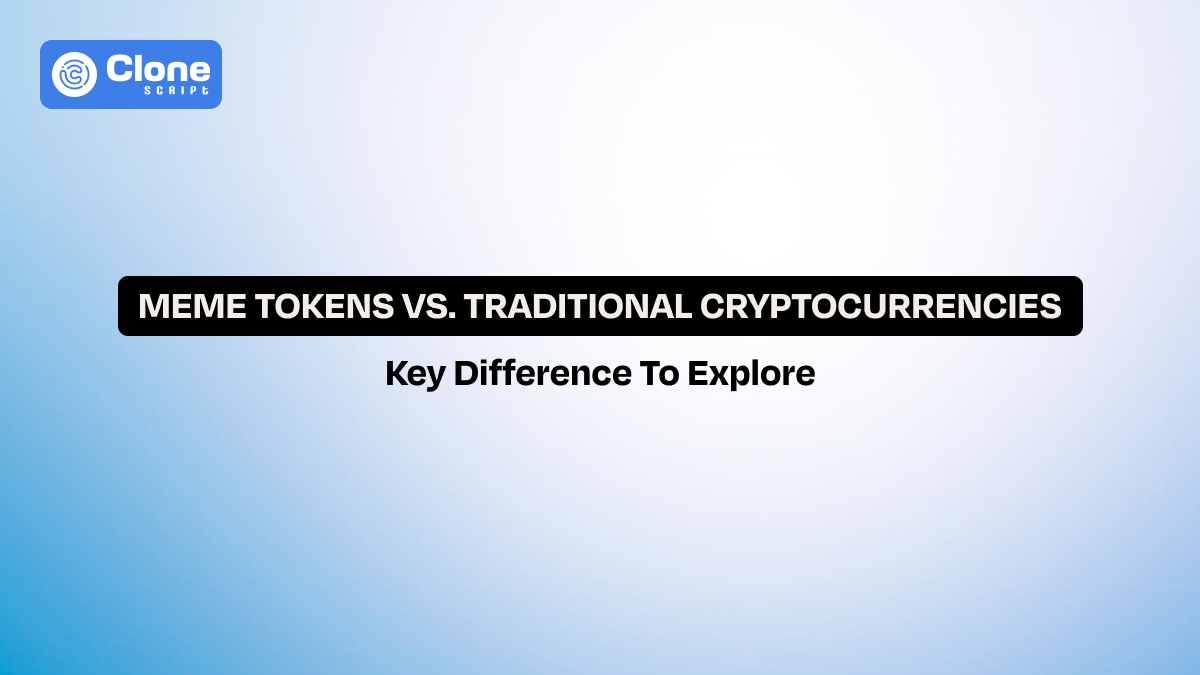Meme Tokens vs. Traditional Cryptocurrencies: What’s the Difference?
In 2025, meme tokens aren’t just internet jokes anymore—they’ve become a market force. Coins like Dogecoin, Shiba Inu, and Pepe have surged in popularity, at times pushing the meme token market cap past $100 billion. Yet, traditional cryptocurrencies like Bitcoin and Ethereum still dominate in adoption, utility, and long-term stability. This contrast raises a key question: meme token vs crypto—what really matters for businesses and investors?
In this blog, we’ll break down the difference between meme coins and cryptocurrencies, explore risks and rewards, and explain how both can impact your website or business strategy.
What Are Traditional Cryptocurrencies?
Traditional cryptocurrencies are digital assets built with utility, security, and long-term adoption in mind. They are not just speculative tokens but part of a broader financial and technological system.
-
Bitcoin (BTC): Launched in 2009, often called “digital gold.” Its primary role is as a store of value and a decentralized payment system. In 2025, Bitcoin still holds over 50% market dominance.
-
Ethereum (ETH): Introduced in 2015, it powers smart contracts and decentralized applications (dApps). Ethereum is the key currency of DeFi, NFTs, and tokenization projects, commanding at least 15% of the total crypto market cap.
-
Other altcoins: Altcoins like Solana, Avalanche, and Cardano, which focus on scalability, energy efficiency, or specialized use cases.
These currencies are backed by clear whitepapers, audited code, governance systems, and institutional recognition. They offer businesses and websites a safer, more credible choice when integrating crypto payments or educating audiences.
What Are Meme Tokens?
A meme token (or meme coin) is a cryptocurrency that gains value primarily from community hype, internet memes, and social media buzz rather than intrinsic utility.
Here are some famous meme coins to explore:
-
Dogecoin (DOGE): Originally a joke, but in 2021–2025 it became a top 10 cryptocurrency. Elon Musk’s tweets famously caused price surges.
-
Shiba Inu (SHIB): Nicknamed the “Dogecoin killer,” it built a strong community and launched Shibarium, a scaling solution, to add utility.
-
PEPE, Bonk, WIF: Newer meme tokens that went viral in 2024–2025, delivering short-term gains of 200–500% in weeks.
Stats about meme coins to know:
-
In 2024, meme tokens surged 424%, pushing their total market cap to $116 billion before cooling down in 2025.
-
Dogecoin remains the largest meme coin, with a market cap of over $15 billion, while PEPE and Bonk are in the multi-billion-dollar range.
Unlike traditional cryptocurrencies, meme tokens often launch with little roadmap—but community engagement and viral marketing can make them household names overnight.
Meme Tokens vs. Traditional Cryptocurrencies
To understand the difference between meme coins and cryptocurrencies, let’s compare them side by side.
|
Aspect |
Traditional Cryptocurrencies (e.g., BTC, ETH) |
Meme Tokens (e.g. DOGE, SHIB, PEPE) |
|---|---|---|
| Purpose |
Payments, smart contracts, DeFi, store of value |
Culture, memes, hype, speculative gains |
|
Market Cap |
Hundreds of billions (BTC > $500B in 2025) |
Tens of billions (DOGE ~ $15B) |
| Volatility |
High, but less extreme (BTC is ~3x less volatile than DOGE) |
Extreme swings; can gain/lose 70% in days |
| Adoption |
Payments, dApps, institutions |
Mostly speculative, some payment uses |
|
Regulation |
Increasingly accepted as commodities |
Unclear, high scrutiny, risk of bans |
|
Investor Base |
Institutions, businesses, developers, long-term holders |
Retail traders, meme communities, and short-term speculators |
You have a question: how are meme tokens different from Bitcoin and Ethereum?
BTC and ETH are built for utility and infrastructure, while meme tokens rely on attention cycles and cultural relevance.
Benefits & Risks of Meme Tokens and Traditional Cryptocurrencies
Here’s an overview of potential benefits and risks to consider for both digital currencies:
Benefits of Traditional Cryptocurrencies
Choosing the traditional cryptocurrencies brings the following advantages:
-
Utility-driven: These currencies support payments, smart contracts, dApps, governance, and tokenization of real-world assets. For example, Ethereum’s network secures over $50 billion in DeFi value.
-
Institutional trust: ETFs, corporate holdings, and regulated products (e.g., spot Bitcoin ETFs approved in 2024) give investors confidence. Even companies like Tesla and MicroStrategy hold Bitcoin as part of their reserves.
-
Liquidity: Traditional crypto is easy to buy/sell at scale without major price impact. BTC trades average $30–40 billion daily. It is one of the most liquid assets globally.
-
Long-term growth: Despite volatility, BTC has grown approximately 12,000% since 2013 and is often seen as a useful asset against inflation.
-
Global adoption: Bitcoin is now recognized as legal tender in two countries (El Salvador, the Central African Republic) and accepted by thousands of businesses worldwide.
Risks of Traditional Cryptocurrencies
The potential disadvantages of cryptocurrencies involve:
-
Regulation: SEC lawsuits, government restrictions, and tax compliance issues create uncertainty, especially for altcoins. There’s no centralized institute to regulate the price of BTC and ETH.
-
Scalability: Network congestion and high gas fees (especially on Ethereum) remain barriers for mainstream adoption. So, if any startup wants to accept payments from customers, it prevents them from integrating crypto gateways.
-
Volatility: Still subject to steep corrections—BTC fell 70% in 2022 before recovering in 2023. This uncertainty results in a loss of base cost coverage for the receiver.
-
Technology risks: Hacks of DeFi protocols or bridge exploits can impact ecosystems built on traditional cryptocurrencies.
Benefits of Meme Tokens
The potential advantages of meme coins include:
-
Massive upside potential: Early investors in SHIB or PEPE saw life-changing gains. Some are turning $1,000 into millions during peak hype cycles.
-
Viral marketing: Meme coin community-driven growth management makes them easy to promote on social platforms like Reddit, TikTok, and X.
-
Low entry barrier: These tokens often trade at low cents and fees. So, it becomes psychologically appealing for new investors.
-
Brand engagement: Businesses, influencers, and creators can leverage memes to boost visibility and online traffic. Some even launch branded tokens to build communities.
-
Innovation gateway: Meme coins introduce newcomers to crypto, acting as a “fun” entry point before they explore Bitcoin, Ethereum, or altcoins.
Risks of Meme Tokens
Here are the risks of investing in meme coins:
-
Pump-and-dump schemes: Roughly 25% of new meme coins show signs of scam behavior, from rug pulls to sudden liquidity removal. So, a new user looks suspicious before investing in it.
-
Liquidity traps: Some meme tokens lack sufficient volume, making it hard to exit without triggering massive price drops. Covering the investment value is roughly impossible.
-
Over-dependence on hype: Once social buzz fades, prices can collapse by 80–90% in weeks. Once a celebrity tweets in a positive way, it increases the coin value unexpectedly, but if someone criticizes the project, the price drops very badly.
-
Regulatory crackdowns: Meme tokens could face delisting or outright bans in markets that are tightening investor protection laws.
-
Lack of fundamentals: Unlike BTC or ETH, most meme coins have no roadmap, developer backing, or real-world use case.
Investing in cryptocurrencies and meme coins has to be a balanced choice to keep the meme coin investment return realistic.
The Future of Meme Tokens and Cryptocurrencies
Here is an overview of how meme coins and cryptocurrencies look in the future:
-
Institutionalization of Meme Tokens
The line between speculation and legitimacy is blurring. In September 2025, the launch of the first Dogecoin ETF (DOJE) marked a milestone, giving retail and institutional investors regulated access to meme coins. This follows the success of Bitcoin and Ethereum ETFs, which collectively attracted over $30 billion in inflows in 2024.
While Dogecoin’s ETF is still niche, it shows that meme tokens may slowly move into the mainstream financial system—especially those with large, active communities.
-
Regulatory Tightening
Governments worldwide are working to rein in crypto markets, and meme tokens are in the spotlight. The SEC and EU regulators have signaled that tokens marketed primarily as speculative investments could be classified as securities. This means stricter compliance, transparency requirements, and potential penalties for projects that fail to disclose risks.
Countries like Japan and Singapore already require detailed listings for meme coins, a trend likely to spread. For businesses and investors, this means meme tokens may face higher barriers to entry, reducing the number of “pump-and-dump” projects but also limiting free experimentation.
-
Utility Expansion
While meme tokens started as jokes, many are now pursuing real-world applications. Shiba Inu’s Shibarium network is an example, offering a Layer-2 blockchain to reduce fees and enable decentralized apps.
Other meme tokens are experimenting with NFT marketplaces, gaming integrations, and loyalty programs. This evolution hints at a future where meme coins don’t just rely on hype but build hybrid models—half meme, half functional ecosystem—giving them staying power beyond social buzz.
-
Market Cycles
Meme tokens remain highly sensitive to internet culture and community preferences. A viral TikTok trend, celebrity endorsement, or Reddit movement can push prices up by hundreds of percent in days, only for them to crash just as quickly.
In contrast, Bitcoin and Ethereum follow more predictable adoption-driven cycles, tied to halving events, institutional inflows, and regulatory clarity.
Over the next decade, expect meme tokens to continue as short-term speculative plays, while BTC and ETH solidify as long-term infrastructure assets within the financial system.
2026–2030 Snapshot: Predictions at a Glance for Cryptocurrencies and Meme Tokens
Find our prediction of the cryptocurrencies and meme tokens:
-
Traditional cryptocurrencies:
-
Bitcoin could surpass $150,000–$200,000 by 2030, depending on adoption and inflation trends.
-
Ethereum will evolve into a Web3 key factor, powering decentralized finance, tokenized real estate, and global payment rails.
-
Regulatory clarity and institutional adoption may drive cryptocurrencies into mainstream banking and investment portfolios.
-
Meme tokens:
-
Likely to survive in smaller numbers, with only a few (Dogecoin, Shiba Inu, PEPE) becoming semi-legitimate ecosystems.
-
Will continue to get attention on community-driven hype, especially on platforms like TikTok, X, and gaming communities.
-
Possible adoption in entertainment, influencer marketing, and online branding as digital fan tokens.
Key takeaway: Meme tokens will likely remain a speculative “side show” in the crypto market, while Bitcoin and Ethereum continue to anchor the digital economy. Businesses should use meme tokens for community engagement but rely on traditional cryptocurrencies for serious adoption and payments.
Conclusion
The debate around meme tokens vs traditional cryptocurrencies isn’t about which is “better”—it’s about recognizing their different roles. Traditional cryptocurrencies like Bitcoin and Ethereum provide infrastructure, security, and long-term trust, while meme tokens thrive on community hype, cultural relevance, and volatility.
So, are meme tokens a good investment? For most, they’re not a substitute for established crypto—but as part of a diversified strategy, they can add excitement (and potential upside).
FAQs
-
What makes a meme token different from a utility token or altcoin?
A meme token is driven by social media hype, community, and novelty rather than technical utility. Utility tokens/altcoins typically have real use-cases (governance, DeFi, payments), stronger roadmaps, and developer support.
-
Do most meme tokens have any long-term value, or are they purely speculative?
Most meme tokens are speculative short-term plays. Only a small number of those projects evolve with real utility (NFTs, governance, ecosystems). Many fade when community interest or investor attention drops.
-
How risky is investing in meme tokens compared to Bitcoin or Ethereum?
Much riskier. Meme coins usually have higher volatility, weaker fundamentals, and more exposure to scams or regulatory changes. BTC/ETH tend to have more stability, broader adoption, and clearer use cases.
-
How many meme tokens are launched, and why so many?
Massive numbers are launched — thousands globally per month on some platforms. Easy token creation tools, low barriers, and demand for novelty drive volume.
-
What should businesses consider before accepting meme tokens for payment?
Check liquidity, legal status, volatility, and token utility. Also consider customer trust, tech integration costs, and whether large value swings will affect pricing/stability. Use well-known cryptos where possible.
 BTC - Bitcoin
BTC - Bitcoin
 USDTERC20 - USDT ERC20
USDTERC20 - USDT ERC20
 ETH - Ethereum
ETH - Ethereum
 BNB - Binance
BNB - Binance
 BCH - Bitcoin Cash
BCH - Bitcoin Cash
 DOGE - Dogecoin
DOGE - Dogecoin
 TRX - TRON
TRX - TRON
 USDTTRC20 - USD TRC20
USDTTRC20 - USD TRC20
 LTC - LiteCoin
LTC - LiteCoin







